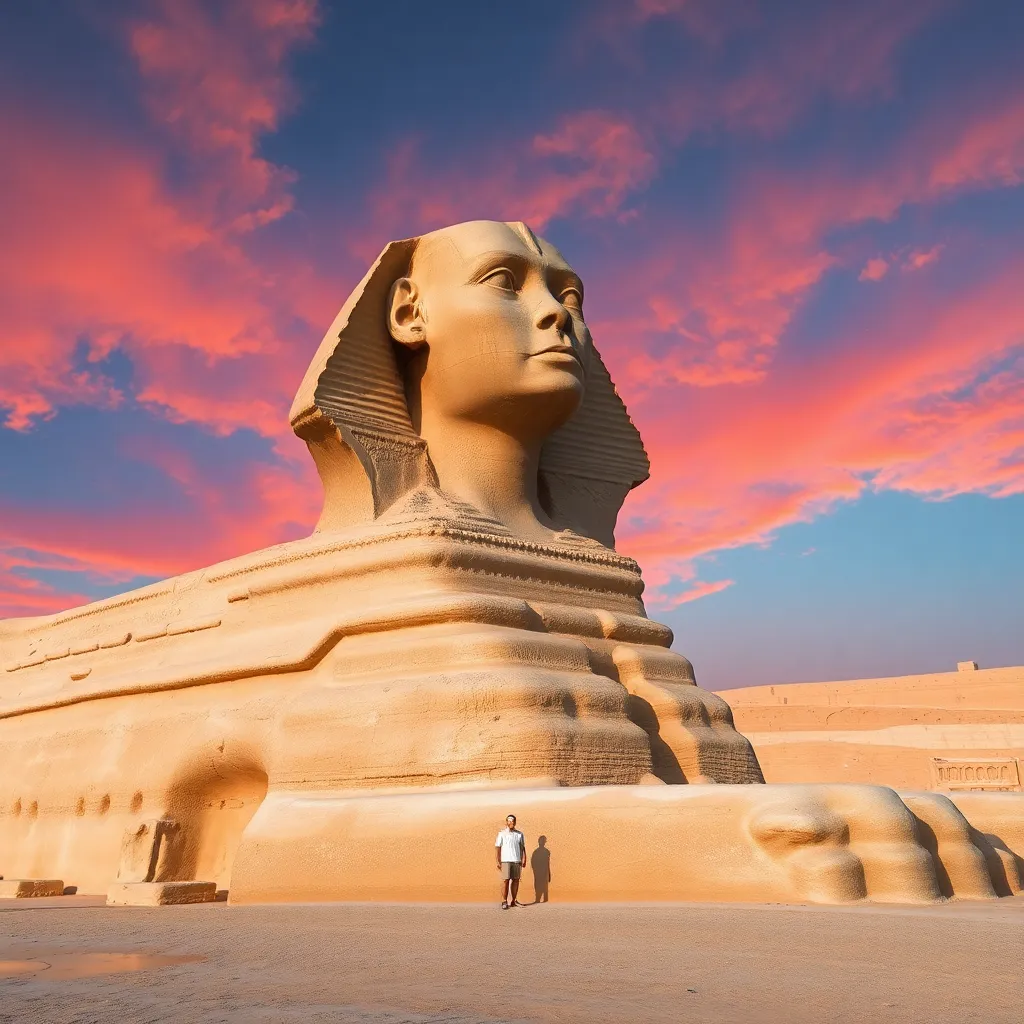The Sphinx: A Reflection of the Natural World
I. Introduction
The Great Sphinx of Giza is one of the most iconic monuments of ancient Egyptian civilization, captivating the imagination of historians, archaeologists, and tourists alike. With its enigmatic expression and colossal size, the Sphinx has stood for millennia as a symbol of strength and mystery. This article delves into the profound connection between the Sphinx and the natural world, exploring its historical significance, architectural features, and the environmental challenges it faces today.
II. Historical Context of the Sphinx
A. Origins and construction of the Sphinx
The Sphinx is believed to have been constructed during the reign of Pharaoh Khafre around 2500 BCE, making it one of the oldest monumental sculptures in the world. Carved from a single mass of limestone, it stands at 66 feet (20 meters) high and stretches 240 feet (73 meters) long. Theories about its purpose suggest it may have served as a guardian of the Giza Plateau, protecting the tombs of the pharaohs.
B. Cultural significance in ancient Egyptian society
In ancient Egyptian culture, the Sphinx represented a powerful fusion of human intellect and animal strength. It served as a symbol of royalty and divine protection, embodying the qualities of the lion—a creature revered for its might and majesty. The Sphinx was central to the religious practices of the time, often associated with the sun god Ra and the pharaoh’s role as a mediator between the gods and the people.
III. The Sphinx’s Architectural Features
A. Description of the Sphinx’s design and structure
The design of the Sphinx is characterized by its lion’s body and human head, which is believed to represent Pharaoh Khafre himself. The face of the Sphinx, although weathered, is thought to have originally been adorned with a headdress, further emphasizing its royal connection. The precision of the carving and the scale of the structure reflect the advanced engineering skills of the ancient Egyptians.
B. Symbolism of the lion and human features
The lion symbolizes strength, courage, and protection, while the human face signifies intelligence and wisdom. This combination suggests that the Sphinx was not only a guardian of the necropolis but also a representation of the pharaoh’s divine authority. The duality of its form connects the earthly realm with the celestial, reinforcing the belief in the pharaoh’s role as a god on earth.
IV. The Sphinx and Its Geographic Setting
A. The relationship between the Sphinx and the Giza plateau
The Sphinx is strategically located on the Giza Plateau, adjacent to the Pyramids of Giza. This location is not merely coincidental; it was chosen for its visibility and prominence in the ancient landscape. The alignment of the Sphinx with the pyramids enhances its role as a protector of the royal tombs, creating a powerful architectural complex that reflects the Egyptians’ reverence for the afterlife.
B. Natural elements influencing the Sphinx’s location
The natural landscape of the Giza Plateau, characterized by vast sandy plains and the backdrop of the desert, contributes to the Sphinx’s imposing presence. The proximity to the Nile River also played a crucial role in the choice of location, as the river was central to the agricultural and spiritual life of ancient Egyptians, linking them to the natural world.
V. The Sphinx in Art and Literature
A. Depictions of the Sphinx in ancient art
The Sphinx has been a popular subject in ancient Egyptian art, often depicted in various forms, including statues, reliefs, and paintings. These representations highlight its significance in religious and royal iconography, showcasing the reverence ancient Egyptians held for this monumental figure.
B. The Sphinx’s influence on literature and mythology
The Sphinx has transcended its geographical and temporal origins, influencing literature and mythology across cultures. In Greek mythology, the Sphinx is portrayed as a riddling creature that poses a deadly challenge to travelers. This adaptation of the Sphinx reflects its enigmatic nature and the fascination it has inspired throughout history.
VI. The Sphinx as a Symbol of Nature
A. Interpretations of the Sphinx as a guardian of the desert
As a colossal figure carved from the earth, the Sphinx embodies the essence of the desert landscape. It is often interpreted as a guardian of the arid environment, watching over the vast sands and protecting the secrets of the ancient world. This interpretation reinforces the connection between the Sphinx and the natural elements of the region.
B. The Sphinx’s connection to the sun and celestial bodies
The Sphinx’s alignment with the sun’s path has led to interpretations of it as a solar deity. The ancient Egyptians had a profound relationship with the sun, viewing it as a source of life and regeneration. The Sphinx, in its majestic stillness, serves as a reminder of the cyclical nature of life and the divine order of the cosmos.
VII. Conservation and Environmental Challenges
A. Natural erosion and its effects on the Sphinx
Despite its grandeur, the Sphinx faces significant threats from natural erosion, weathering, and pollution. Wind and sandstorms have gradually worn away its surface, causing damage to its facial features and body. The impact of climate change and increased tourism further exacerbates these challenges, threatening the integrity of this ancient symbol.
B. Efforts to preserve the Sphinx amidst environmental threats
Numerous conservation efforts are underway to preserve the Sphinx for future generations. These initiatives include:
- Regular maintenance and restoration work to repair weathered areas.
- Implementing protective measures to shield the Sphinx from environmental factors.
- Raising awareness about the importance of preserving this iconic monument.
VIII. Conclusion
The Great Sphinx of Giza stands as a testament to the ingenuity of ancient Egyptian civilization and its deep connections to the natural world. Its majestic presence continues to inspire awe and admiration, serving as a symbol of strength, mystery, and the enduring legacy of human creativity. As we confront the challenges of preservation and climate change, the Sphinx remains a powerful reminder of our responsibility to protect our cultural heritage and the environment for future generations.




